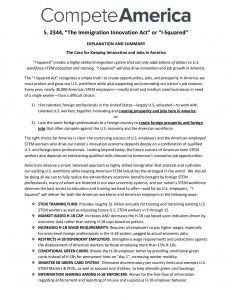S. 2344, “The Immigration Innovation Act” or “I-Squared”
EXPLANATION AND SUMMARY
The Case for Keeping Innovation and Jobs in America
“I-Squared” creates a highly skilled immigration system that not only adds billions of dollars to U.S. workforce STEM education and training; “I-Squared” will also drive innovation and job growth in America.
The “I-Squared Act” recognizes a simple truth: to create opportunities, jobs, and prosperity in America, we must protect and grow our U.S. workforce while also supporting and promoting our nation’s job creators. Every year, nearly 30,000 American STEM employers—mostly small and medium sized businesses in need of a single worker—face a difficult choice:
1) Hire talented, foreign professionals in the United States—largely U.S.-educated—to work with talented U.S. workers, together innovating and creating prosperity and jobs here in America;
-or-
2) Lose the same foreign professionals to a foreign country to create foreign prosperity and foreign jobs that often compete against the U.S. economy and the American workforce.
The right choice for America is clear: the continuing success of U.S. employers and the American-employed STEM workers who drive our nation’s innovation economy depends deeply on a combination of qualified U.S. and foreign-born professionals. Looking beyond today, the future success of American-born STEM workers also depends on maintaining qualified skills relevant to tomorrow’s innovative job opportunities.
Americans deserve a smart, balanced approach to highly skilled immigration that protects and cultivates our existing U.S. workforce while keeping American STEM industries the strongest in the world. We should be doing all we can to fully realize the extraordinary economic benefits brought by foreign STEM professionals, many of whom are fostered in our own university systems, and our nation’s STEM workforce deserves the best access to education and training we have to offer—paid for by U.S. employers. “I-Squared” will deliver for both the American workforce and American employers in the following ways:
STEM TRAINING FUND: Provides roughly $1 billion annually for training and retraining existing U.S. STEM workers as well as educating future U.S. STEM workers in K through 12.
MARKET-BASED H-1B CAP: Increases AND decreases the H-1B cap based upon indicators driven by economic data rather than setting H-1B caps based on politics.
INCREASED H-1B WAGE REQUIREMENTS: Requires all employers to pay higher wages, especially for entry-level foreign professionals in the H-1B system, pegged to actual economic data.
RESTRICTS H-1B DEPENDENT EMPLOYERS: Strengthens wage requirements and protections against the displacement of American workers by those employing more than 15% H-1Bs.
CONDITIONAL GREEN CARDS: Breaks the H-1B-employer tether by providing conditional green cards instead of H-1Bs for permanent hires on “day 1”, increasing worker mobility.
SMARTER EB GREEN CARD SYSTEM: Eliminates discriminatory per country limits and exempts U.S. STEM Masters & PhDs, as well as spouses and children, to help alleviate green card backlogs.
INFORMATION SHARING AMONG H-1B ENFORCERS: Allows for the free flow of information regarding enforcement and reporting of misuse and suspicious H-1B employer behavior.

